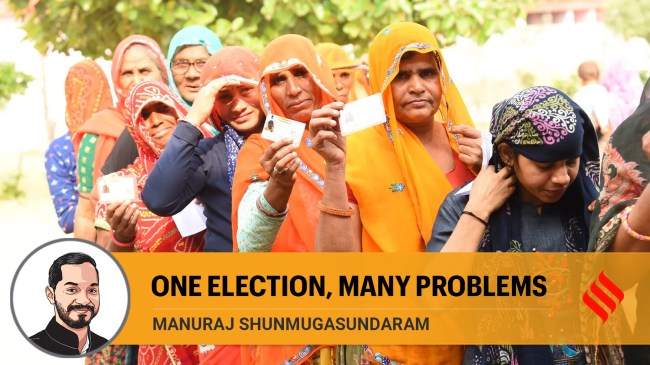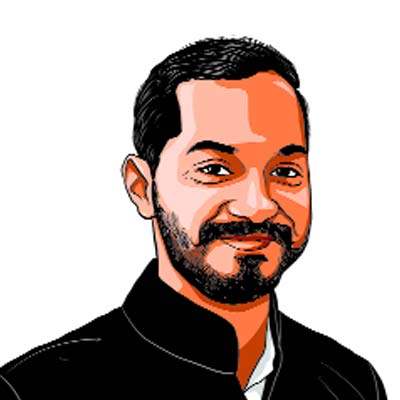Opinion The case against One Nation, One Election
When the ECI requires five phases for the Jharkhand Assembly Election and eight phases for the West Bengal Assembly Election, how will simultaneous elections be held across the country?
 Though the Supreme Court would have the final say on the constitutionality of simultaneous elections, a repeat electoral victory in 2024 for a Modi-led BJP would be understood as a resounding affirmation of ONOE. (Express photo)
Though the Supreme Court would have the final say on the constitutionality of simultaneous elections, a repeat electoral victory in 2024 for a Modi-led BJP would be understood as a resounding affirmation of ONOE. (Express photo) On the cusp of election season, the High-Level Committee (HLC) on One Nation, One Election (ONOE), led by former President of India Ramnath Kovind, submitted its recommendations to the President. Though the primary import of these recommendations would not be realised until 2029, this exercise indicates how democracy itself can be fundamentally altered through a partisan process. Though the Supreme Court would have the final say on the constitutionality of simultaneous elections, a repeat electoral victory in 2024 for a Modi-led BJP would be understood as a resounding affirmation of ONOE.
The HLC’s report has made recommendations in favour of simultaneous elections starting from 2029. It suggests a two-phased strategy across all tiers of government. It also suggests amending Articles 83 and 172 of the Constitution to enable simultaneous elections to the state legislative assemblies and the House of the People without requiring state ratification. Further, it suggests that fresh elections for state legislative assemblies will be held for the remainder of the term in the event of a hung House, a no confidence motion, or an unexpired dissolution of the assembly. This means that any government constituted between election terms would necessarily be only for a term which is equal to the remainder of the time left before the next election date. There are unavoidable constitutional barriers to these recommendations. For instance, the Constitution currently provides an equal five-year tenure for every elected assembly and Parliament. An amendment to this will impair the constitutional right that is endowed with each voter and the returned candidate.
Last month, the Tamil Nadu Legislative Assembly had pre-emptively resolved to urge the Union government to not implement the ONOE policy. Chief Minister M K Stalin termed the policy as a “dangerous, autocratic thought and it needs to be opposed”. The Tamil Nadu Assembly pointed out that the concept of simultaneous elections is not found in the Constitution of India and goes against the foundational principles of democracy.
The concern that simultaneous elections at all tiers would go against the grain of federalism is serious. The Indian Constitution establishes a three-tier system of government, at the Union, state and panchayat (local bodies) levels in order to promote representative democracy through increased participation. Based on election data, voters in all three elections raise distinct demands and approach each with different agendas. What needs to be addressed at the national level through parliamentary law-making is vastly different from what is addressed by the local municipal corporation. While matters of foreign policy, income tax or national security would dominate the headlines during the general elections, issues around water, property tax and roads would dominate the agenda during the local bodies’ elections. There is a concern that combining elections at various levels might blur this distinction, leading to a centralised approach that could neglect local issues and dilute lower-tier democratic representation.
As a constitutional body, the ECI is mandated with the superintendence of elections. It is expected to be a neutral and autonomous body that holds free and fair elections. The recent conduct of the ECI, including the resignation and subsequent appointment of two commissioners, raises questions about its authority and whether the body is functioning in an independent capacity. In such circumstances, we must view the ECI’s endorsement of simultaneous elections with utmost vigilance. When the ECI requires five phases for the Jharkhand Assembly Election and eight phases for the West Bengal Assembly Election, how will simultaneous elections be held across the country? It is not clear whether ECI or the HLC have done a rounded logistical assessment of the requirements to hold simultaneous elections in terms of security personnel, election officials, voting machines, etc.
In Kesavananda Bharati vs State of Kerala (1973), the Supreme Court asserted the primacy of the basic structure of the Constitution over the legislature. In the Indira Gandhi election case [(Indira Gandhi vs Raj Narain, (1975)], the Court speaking through Justice H R Khanna held that democracy is a basic feature of the Constitution and this includes free and fair elections. Therefore, the question of whether elections are being conducted in a manner that is impartial, free, and fair is something that the Court needs to look at very closely in order to avoid any adverse outcomes. The SC, in the recent Chandigarh mayoral election case [(Kuldeep Kumar vs UT Chandigarh and Ors (2024)], had shown constitutional alacrity to exercise its judicial review powers to interfere in an electoral farce. It is the duty of constitutional courts to monitor and effectively respond to the excesses of the executive and legislative branches of the government.
No doubt that the debate surrounding ONOE reflects broader tensions between efficiency, constitutional supremacy, and federalism within the Indian polity. The resolution of these issues will likely require careful deliberation, balancing competing interests to uphold the principles of democracy and federalism entrenched in the Constitution of India. While the recommendations for One Nation, One Election seem to concern the 2029 elections, the public referendum for it will be held in May 2024.
The writer is an advocate practising in the High Court of Madras and National Media Spokesperson, DMK. Inputs provided by Dhileepan P


